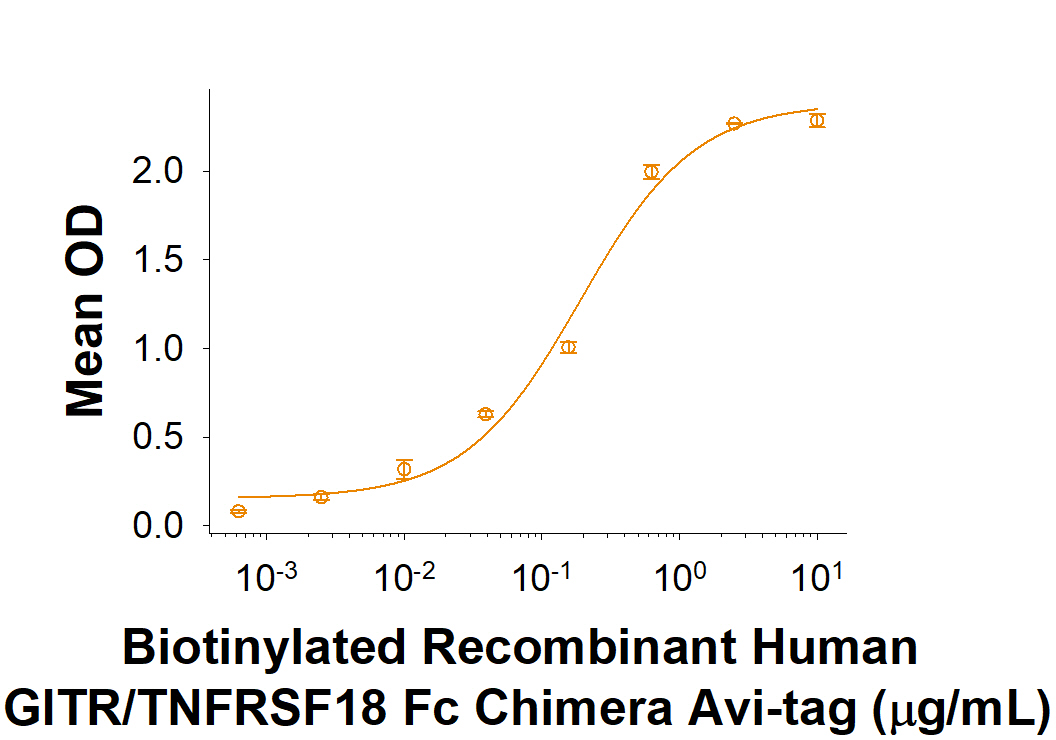Recombinant Human GITR/TNFRSF18 Fc Avi-tag Protein, CF
Recombinant Human GITR/TNFRSF18 Fc Avi-tag Protein, CF Summary
Learn more about Avi-tag Biotinylated ProteinsWhy choose R&D Systems Avi-tag GITR Protein?
- Guaranteed Bioactivity and High Purity: Bioactivity tested by functional ELISA and purity determined by SDS-PAGE to be greater than 95%.
- Lot-to-Lot Consistency: Stringent QC testing performed on each lot to ensure consistent activity and purity.
- Bulk Quantities Available: Bulk up and save with large mass quantities to meet your research needs. Supply agreements available, partner with us. Please contact us.
- Most Respected, Most Cited Brand in Proteins: With over 35 years of providing the best recombinant proteins to the scientific community, R&D Systems continues to lead the industry in quality, activity, and purity.
Product Specifications
| GITR/TNFRSF18 (Gln26-Glu161) Accession # Q9Y5U5.1 | IEGRMD | Human IgG1 (Pro100-Lys330) | Avi-tag |
Analysis
Product Datasheets
Carrier Free
CF stands for Carrier Free (CF). We typically add Bovine Serum Albumin (BSA) as a carrier protein to our recombinant proteins. Adding a carrier protein enhances protein stability, increases shelf-life, and allows the recombinant protein to be stored at a more dilute concentration. The carrier free version does not contain BSA.
In general, we advise purchasing the recombinant protein with BSA for use in cell or tissue culture, or as an ELISA standard. In contrast, the carrier free protein is recommended for applications, in which the presence of BSA could interfere.
AVI689
| Formulation | Lyophilized from a 0.2 μm filtered solution in PBS with Trehalose. |
| Reconstitution | Reconstitute at 500 μg/mL in PBS. |
| Shipping | The product is shipped at ambient temperature. Upon receipt, store it immediately at the temperature recommended below. |
| Stability & Storage: | Use a manual defrost freezer and avoid repeated freeze-thaw cycles.
|
Scientific Data
 View Larger
View Larger
When Recombinant Human GITR Ligand/TNFSF18 (Catalog # 6987-GL) is immobilized at 0.5 µg/mL, 100 µL/well, Biotinylated Recombinant Human GITR/TNFRSF18 Fc Chimera Avi-tag (Catalog # AVI689) binds with an ED50 of 0.05-0.5 µg/mL.
 View Larger
View Larger
2 μg/lane of Biotinylated Recombinant Human GITR/TNFRSF18 Fc Chimera Avi-tag (Catalog # AVI689) was resolved with SDS-PAGE under reducing (R) and non-reducing (NR) conditions and visualized by Coomassie® Blue staining, showing bands at 54-60 kDa and 108-120 kDa.
Reconstitution Calculator
Background: GITR/TNFRSF18
GITR (glucocorticoid-induced tumor necrosis factor receptor), also known as AITR and TNFRSF18, is a 40 kDa transmembrane glycoprotein that functions in immune regulation (1, 2). Mature human GITR consists of a 137 amino acid (aa) extracellular domain (ECD) with three tandem TNFR cysteine-rich repeats, a 21 aa transmembrane segment, and a 58 aa cytoplasmic domain (3, 4). Within the ECD, human GITR shares 55% and 60% aa sequence identity with mouse and rat GITR, respectively. Alternative splicing generates an isoform with a short deletion in the cytoplasmic domain and a potentially secreted isoform that is substituted within the third TNFR repeat and lacks the transmembrane and cytoplasmic regions. GITR is expressed on CD4+CD25+ regulatory T cells (Treg) as well as on subsets of thymocytes, lymph node cells, and splenocytes (4-6), and it is upregulated on antigen-activated conventional CD4+ and CD8+ T cells (3, 4, 6, 7). GITR binding by GITR Ligand/TNFSF18 costimulates the proliferation and activation of CD4+ or CD8+ conventional T cells (3, 7-9). It also induces the proliferation of Treg (8, 10) but inhibits the ability of Treg to suppress immune responses (5, 8, 11-13). This can result in the development of autoimmunity, increased tumor cell killing by effector T cells (5, 11), and increased inflammation in arthritis, allergic asthma, and inflammatory bowel disease (10, 14). GITR is also expressed on sympathetic neurons where it enhances NGF-induced neurite outgrowth and branching (15).
- Clouthier, D.L. and T.H. Watts (2014) Cytokine Growth Factor Rev. 25:91.
- Ronchetti, S. et al. (2015) J. Immunol. Res. 2015:171520.
- Gurney, A.L. et al. (1999) Curr. Biol. 9:215.
- Kwon, B. et al. (1999) J. Biol. Chem. 274:6056.
- Shimizu, J. et al. (2002) Nat. Immunol. 3:135.
- Nocentini, G. et al. (1997) Proc. Natl. Acad. Sci. USA 94:6216.
- Muriglan, S.J. et al. (2004) J. Exp. Med. 200:149.
- Ronchetti, S. et al. (2004) Eur. J. Immunol. 34:613.
- Tone, M. et al. (2003) Proc. Natl. Acad. Sci. USA 100:15059.
- Ephrem, A. et al. (2013) Eur. J. Immunol. 43:2421.
- Ko, K. et al. (2005) J. Exp. Med. 202:885.
- Ji, H. et al. (2004) J. Immunol. 172:5823.
- Stephens, G.L. et al. (2004) J. Immunol. 173:5008.
- Patel, M. et al. (2005) Eur. J. Immunol. 35:3581.
- O'Keeffe, G.W. et al. (2008) Nat. Neurosci. 11:135.
FAQs
No product specific FAQs exist for this product, however you may
View all Proteins and Enzyme FAQsReviews for Recombinant Human GITR/TNFRSF18 Fc Avi-tag Protein, CF
There are currently no reviews for this product. Be the first to review Recombinant Human GITR/TNFRSF18 Fc Avi-tag Protein, CF and earn rewards!
Have you used Recombinant Human GITR/TNFRSF18 Fc Avi-tag Protein, CF?
Submit a review and receive an Amazon gift card.
$25/€18/£15/$25CAN/¥75 Yuan/¥2500 Yen for a review with an image
$10/€7/£6/$10 CAD/¥70 Yuan/¥1110 Yen for a review without an image

